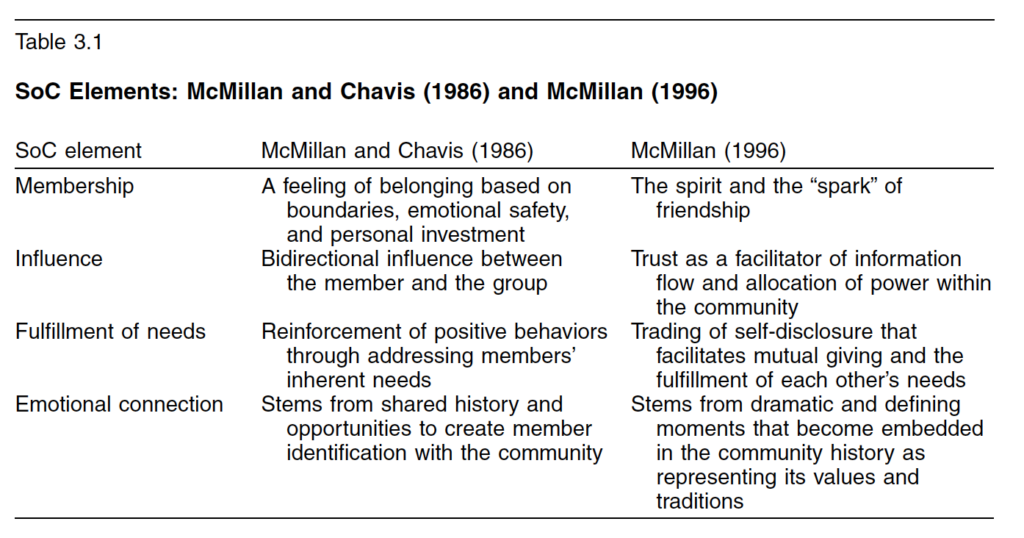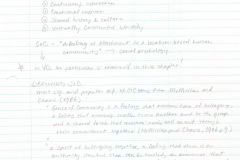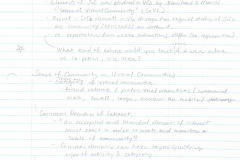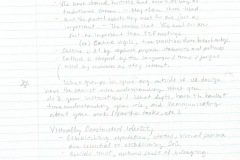
By Dana Rotman and Philip Fei Wu
April 23, 2020
- “Sense of Community” (SoC) is differentiated from “just community”
- Five elements of SoC:
- Common domain of interest
- Continuous interaction
- Emotional support
- Shared history and culture
- Virtually constructed identity
- SoC = ” a feeling of attachment to a location-based human community” (social psychology)
- SoCs in VCs in particular is examined in this chapter
Defining Sense of Community
- Most significant and popular definition of SoC comes from McMillan and Chavis (1986):
Sense of Community is a feeling that members have of belonging, a feeling that members matter to one another and to the group, and a shared faith that members’ needs will be net through their commitment together.
McMillan and Chavis, 1986, page 9
[Sense of Community is] a spirit of belonging together, a feeling that there is an authority structure than can be trusted, an awareness that trade and mutual benefit come from being together, and a spirit that comes from shared experiences
McMillan, 1996, page 315
- SoCs facilitate member’s interactions
- McMillan and Chavis’ Sense of Community elements:
- Membership — belonging
- Boundaries — of who’s in / not
- Emotional safety — result of 1 and 2
- Personal investment — strength of ties = more values
Influence
- Leads to motivations for participation
- Reciprocal; give and receive
- “Consensual validation”; bidirectional conformity
- Norms validate each other’s experiences
- One becomes more influential by being open to being influenced first, and then contributing back through participation
- Perhaps influential UX designers on VCs are also actively contributing back
Fulfilment of Needs
- Build “community economy” in mutual building
- Similar competency is required for bothies to benefit
- Competence is expected
Shared Emotional Connection
- Achieved through “positive ways to interact, important events to share, ways to resolve them positively, honour members, invest in the community…”
- Quality over quantity (frequency)

Sense of Community in Virtual Environments
- There was initial fear amongst scholars that sense of communities would decrease because of VCs
- Late 1990s – “virtual communities”, “virtual settlement” terms increased
- VCs offer “virtual haven” in place of physical interaction
- Stronger SoC leads to sustainable VC
- Elements of SoC was studied in VCs by Blanchard and Marcus (Sense of Virtual Community)
- Result: SoC elements in VCs diverge from original studies of SoCs because community STRUCTURES are different
- Ex. expectations from online interactions differ (ex. response time)
- What information would you prefer looking up online over finding the right person to ask?
Sense of Community is Virtual Communities
- There are categories of virtual communities: friend network, professional connections, commercial ties, small, large, mobile, stationary…
- Common Domain of Interest
- an “accepted and bounded domain of interest must exist in order to create and maintain a sense of community”
- Common domains can have additional layers of types of activities
- Continuous Interaction
- This is what brings members together and creates community body
- This ranges from practical answers to emotional reactions
- Members take on different roles
- Do you find yourself as an information seeker or giver? Do you find yourself asking a lot of questions to your design team or providing a lot of answers?
- Emotional Support
- Required for successful VCs (increased sense of trust)
- You need a “safe haven for expressing opinions”
- Fills in the gap for not having personal ties
- Shared History and Culture
- VCs have shared histories that aren’t as long as traditional communities; they are often short-lived
- But the pivotal events they meet for as just as important; the reasons why VCs form are just as important as causes for F2F meetings
- Ex. online vigils, emergency data breach meetings
- VC culture is set by explicit purpose statements and policies
- VC culture is shaped by the language / terms / jargon used by members as they interact
- What groups in your organization outside of UX design have the easiest time understanding what you do and following your instructions?
- Which teams / departments / roles in your organization do you think has no idea what your role is? Do you feel the pressure to have to prove what you do to them?
- Virtually Constructed Identity
- Establishing reputation, status, virtual persona are essential to establishing SoC
- Builds trust, nurtures sense of belonging
A New Framework of Sense of Community
- Proposed conceptual framework
- This framework captures the changing nature of SoC in VCs
- Shifts int he course of VC formation and development
- Topicality to Domain
- Topicality / domain can start broad in VCs and can contain various topics
- Topics can create subtopics as VC develops
- This leads to a SoC
- Information to Interaction
- Interaction is more than information sharing
- Interaction helps users of various motivations to have their diverse needs met
- Interaction enables the VC to not only serve as a platform for information but for socializing too
- Information to Affection
- Repeated interaction in VCs build a greater sense of trust
- Trust creates an environment to share personal information which encourages others to reciprocate and build greater mutual trust
- This establishes stronger sense of SoC
- Story to History
- VCs leave a digital trace – this shared history is accessible by new members and lurkers
- Making history accessible allows outside members to learn the VC culture
- Anonymity to Identity
- “any type of visual identity in VCs promotes recognition and identities in real life”
- How you participate shapes your identity too
- This is a working conceptual framework. It can vary differently for each VC depending on the context of the community
- This conceptual framework would be more helpful if my objective was to build a VC / analyze an existing VC
- Using this concept o SoC, I can ask UX designers how they perceive themselves in any communities they associate with
- How are you sharing your design experiences and knowledge today? Is it mostly done in the workplace? Does it get published / shared internally and/or externally? Do you talk about it with friends that have similar occupations? Do you share your experiences and lessons learned in social media, personal portfolio, CVs? How else would you like to share what you know?
- This article ends with a call our for more empirical studies on SoCs n VCs and how SoCs can be improved by design






